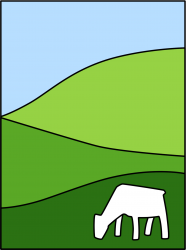Its all about the price of FEED!
Historically, dairy farmers have always faced a conundrum – especially in New Zealand.
That challenge is;
“With a given amount of feed available on my farm how do I prioritize which class of my animals to I feed it to?”
In the past when dairy farms were ‘self-contained’ (how long since you have heard that expression) it was easy. The milking herd got all the best stuff and the replacements got the back paddock, the steep gully and anything that was left after the herd had their share!
It all seemed to make sense. Because it was the herd that produced the income, they should be fed more to produce more.
To appreciate this conundrum, one should know that a milking herd usually has about 25% of new heifers enter each year. Because they are 2 years of age, there are 2 age groups (being about 33% of the total herd) being grown at any one time. The replacements require about 25% of the total herds feed.
The replacements didn’t produce any income, so they didn’t get the pick of feed. ‘Heifer Hay’ was the hay not good enough to feed to the herd. It didn’t seem to matter that the heifers were small at first calving, the researchers and academics talked about weights of 280 kilograms at 24 months of age, and researched how Californian thistle could be controlled by hard grazing with dairy replacements.
Then, over the past 30 years, a quiet revolution took place. Dairy farmers discovered a cheap source of feed. They could send their dairy replacements off-farm to a Grazier who would provide feed at a price low enough for them to profitably use all the on-farm feed for the milking herd. And they could demand that the Grazier provide the day-to-day husbandry (at no cost) plus enough feed to achieve better grown, more profitable heifers. During this 30 years, relative to dairy payout, the price of grazing has declined substantially.
But now – another revolution has started.
Dairy cow numbers are increasing rapidly. Farms that were providing the off-farm grazing and feed are being converted to dairy as a more profitable land use. Good quality land prices have increased dramatically.
And – dairy farmers are discovering that they can purchase off-farm feed and transport it to their dairy farm and make a profit from incremental dairy production.
BUT – Internationally feed has become in short supply because of bio-fuel demand and water shortages and this has rapidly increased food prices with dairy products being one of the first to rise. This fact and a widespread drought in NZ resulted in dairy farmers seeking feed wherever it can be found and suddenly, the worldwide increase in feed costs has arrived locally.
This has put a huge amount of pressure on those supplying Dairy Heifer grazing, especially when it comes to pricing. It does not help that pricing is normally for a period of up to 18 months ahead, which makes it something of a ‘Future Contract’ and the graziers input costs (such as fertilizer) may vary considerably during this time.
'Dairy Support' is the term that is increasingly being used to describe all types of feed available to dairying. It takes many forms such as grazing off various classes of stock, purchasing maize and other crops, pasture (in the form of hay, silage, baleage or fresh), grains and PKE and food by-products such as fruit & vegetable wastage and other food production by-product.
The Grazier also has the opportunity to sell his feed directly to other farmers, and it is the dairy sector who are able to make best use of this feed. In practice what is emerging is that feed, no matter what it is, or where, is becoming a standard price (with appropriate correction for food value and transport).
So the conundrum returns! If all available feed is a similar price, which animals have the priority for full feeding and how does one ensure that the replacements are going to get their fair share?
We may learn something from the USA who are very experienced in fully feeding their herds.
In that country, it is not normal for pasture to be the main feed ration. Most likely it will be a TMR (Total Mixed Ration) and will contain a formulated mixture of forage based fibre, grains, commodities, vitamins & minerals.
The price/value is NOT dependant on which animals the feed goes to and it can flucutate a considerable amount.
There, it is normal practice for a dairy farmer to pay a heifer grower three main fees:
FIRSTLY, a daily fee for the feed ration which may vary depending on current feed costs, plus.
SECONDLY, a fee on a daily basis for husbandry & management, plus.
THIRDLY, fees for mating, health and vaccination programs.
Dairy farmers in NZ are generally efficient at using on-farm pasture and with help from their technical consultants are able to analyze the benefits on incremental feed levels to dairy herds that already have the genetic capability to produce at much higher levels than they currently are – IF they are grown better and fed more during lactation.
By establishing a sound and fair basis for dealing with the price/value and quality aspects of ‘Dairy Support’ then the dairy industry should be able to look forward to the continuation of support.
